Boeing X-37
The Boeing X-37, also known as the Orbital Test Vehicle (OTV), is a reusable robotic spacecraft. It is boosted into space by a launch vehicle, then re-enters Earth's atmosphere and lands as a spaceplane. The X-37 is operated by the United States Space Force[3] for orbital spaceflight missions intended to demonstrate reusable space technologies. It is a 120-percent-scaled derivative of the earlier Boeing X-40. The X-37 began as a NASA project in 1999, before being transferred to the United States Department of Defense in 2004.
| X-37 | |
|---|---|
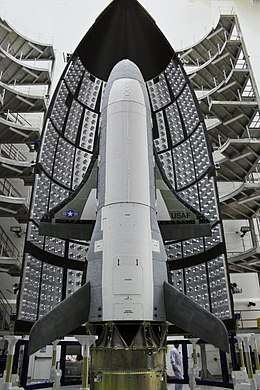 | |
| An X-37B inside its payload fairing | |
| Role | Uncrewed spaceplane |
| National origin | United States |
| Manufacturer | Boeing Defense, Space & Security |
| First flight | 7 April 2006 (first drop test) |
| Introduction | 22 April 2010 (first spaceflight) |
| Status | |
| Primary user |
|
| Number built |
|
| Developed from | Boeing X-40 |
The X-37 first flew during a drop test in 2006; its first orbital mission was launched in April 2010 on an Atlas V rocket, and returned to Earth in December 2010. Subsequent flights gradually extended the mission duration, reaching 780 days in orbit for the fifth mission, the first to launch on a Falcon 9 rocket. The latest sixth mission launched on an Atlas V on 17 May 2020.
Development
Origins
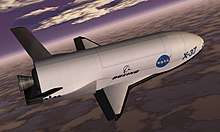
In 1999, NASA selected Boeing Integrated Defense Systems to design and develop an orbital vehicle, built by the California branch of Boeing's Phantom Works. Over a four-year period, a total of US$192 million was spent on the project, with NASA contributing $109 million, the U.S. Air Force $16 million, and Boeing $67 million. In late 2002, a new $301-million contract was awarded to Boeing as part of NASA's Space Launch Initiative framework.[4]
The aerodynamic design of the X-37 was derived from the larger Space Shuttle orbiter, hence the X-37 has a similar lift-to-drag ratio, and a lower cross range at higher altitudes and Mach numbers compared to DARPA's Hypersonic Technology Vehicle.[5] An early requirement for the spacecraft called for a total mission delta-v of 7,000 miles per hour (3.1 km/s) for orbital maneuvers.[6] An early goal for the program was for the X-37 to rendezvous with satellites and perform repairs.[7] The X-37 was originally designed to be carried into orbit in the cargo bay of the Space Shuttle, but underwent redesign for launch on a Delta IV or comparable rocket after it was determined that a shuttle flight would be uneconomical.[8]
The X-37 was transferred from NASA to the Defense Advanced Research Projects Agency (DARPA) on 13 September 2004.[9] Thereafter, the program became a classified project. DARPA promoted the X-37 as part of the independent space policy that the United States Department of Defense has pursued since the 1986 Challenger disaster.
Glide testing
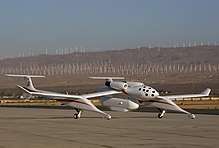
The vehicle that was used as an atmospheric drop test glider had no propulsion system. Instead of an operational vehicle's payload bay doors, it had an enclosed and reinforced upper fuselage structure to allow it to be mated with a mothership. In September 2004, DARPA announced that for its initial atmospheric drop tests the X-37 would be launched from the Scaled Composites White Knight, a high-altitude research aircraft.[10]
On 21 June 2005, the X-37A completed a captive-carry flight underneath the White Knight from Mojave Spaceport in Mojave, California.[11][12] Through the second half of 2005, the X-37A underwent structural upgrades, including the reinforcement of its nose wheel supports. The X-37's public debut was scheduled for its first free flight on 10 March 2006, but was canceled due to an Arctic storm.[13] The next flight attempt, on 15 March 2006, was canceled due to high winds.[13]
On 24 March 2006, the X-37 flew again, but a datalink failure prevented a free flight, and the vehicle returned to the ground still attached to its White Knight carrier aircraft. On 7 April 2006, the X-37 made its first free glide flight. During landing, the vehicle overran the runway and sustained minor damage.[14] Following the vehicle's extended downtime for repairs, the program moved from Mojave to Air Force Plant 42 (KPMD) in Palmdale, California, for the remainder of the flight test program. White Knight continued to be based at Mojave, though it was ferried to Plant 42 when test flights were scheduled. Five additional flights were performed,[N 1] two of which resulted in X-37 releases with successful landings. These two free flights occurred on 18 August 2006 and 26 September 2006.[15]
X-37B Orbital Test Vehicle
On 17 November 2006, the U.S. Air Force announced that it would develop its own variant from NASA's X-37A. The Air Force version was designated the X-37B Orbital Test Vehicle (OTV). The OTV program was built on earlier industry and government efforts by DARPA, NASA, and the Air Force under the leadership of the U.S. Air Force Rapid Capabilities Office in partnership with NASA and the Air Force Research Laboratory. Boeing was the prime contractor for the OTV program.[6][16][17] The X-37B was designed to remain in orbit for up to 270 days at a time.[18] The Secretary of the Air Force stated that the OTV program would focus on "risk reduction, experimentation, and operational concept development for reusable space vehicle technologies, in support of long-term developmental space objectives".[16]
The X-37B was originally scheduled for launch in the payload bay of the Space Shuttle, but following the Space Shuttle Columbia disaster, it was transferred to a Delta II 7920. The X-37B was subsequently transferred to a shrouded configuration on the Atlas V rocket, following concerns over the unshrouded spacecraft's aerodynamic properties during launch.[19] Following their missions, X-37B spacecraft primarily land on a runway at Vandenberg Air Force Base, California, with Edwards Air Force Base as a secondary site.[20] In 2010, manufacturing work began on the second X-37B, OTV-2,[21] which conducted its maiden launch in March 2011.
On 8 October 2014, NASA confirmed that X-37B vehicles would be housed at Kennedy Space Center in Orbiter Processing Facilities (OPF) 1 and 2, hangars previously occupied by the Space Shuttle. Boeing had said the space planes would use OPF-1 in January 2014, and the Air Force had previously said it was considering consolidating X-37B operations, housed at Vandenberg Air Force Base in California, nearer to their launch site at Cape Canaveral. NASA also stated that the program had completed tests to determine whether the X-37B, one-fourth the size of the Space Shuttle, could land on the former Shuttle runways.[22] NASA furthermore stated that renovations of the two hangars would be completed by the end of 2014; the main doors of OPF-1 were marked with the message "Home of the X-37B" by this point.[22]
Most of the activities of the X-37B project are secret. The official U.S. Air Force statement is that the project is "an experimental test program to demonstrate technologies for a reliable, reusable, uncrewed space test platform for the U.S. Air Force".[23] The primary objectives of the X-37B are twofold: reusable spacecraft technology and operating experiments which can be returned to Earth.[23] The Air Force states that this includes testing avionics, flight systems, guidance and navigation, thermal protection, insulation, propulsion, and re-entry systems.[24]
Speculation regarding purpose
In May 2010, Tom Burghardt speculated on Space Daily that the X-37B could be used as a spy satellite or to deliver weapons from space. The Pentagon subsequently denied claims that the X-37B's test missions supported the development of space-based weapons.[25]
In January 2012, allegations were made that the X-37B was being used to spy on China's Tiangong-1 space station module.[26] Former U.S. Air Force orbital analyst Brian Weeden later refuted this claim, emphasizing that the different orbits of the two spacecraft precluded any practical surveillance flybys.[27]
In October 2014, The Guardian reported the claims of security experts that the X-37B was being used "to test reconnaissance and spy sensors, particularly how they hold up against radiation and other hazards of orbit".[28]
In November 2016, the International Business Times speculated that the U.S. government was testing a version of the EmDrive electromagnetic microwave thruster on the fourth flight of the X-37B.[29] In 2009, an EmDrive technology transfer contract with Boeing was undertaken via a State Department TAA and a UK export license, approved by the UK Ministry of Defence.[30][31] Boeing has since stated that it is no longer pursuing this area of research.[32] The U.S. Air Force has stated that the X-37B is testing a Hall-effect thruster system for Aerojet Rocketdyne.[33]
In July 2019 former United States Secretary of the Air Force Heather Wilson explained that when an X-37B was in an elliptic orbit it could at perigee use the thin atmosphere to make an orbit change preventing some observers from discovering the new orbit for a while, permitting secret activities.[34]
Astronomer Jonathan McDowell, editor of Jonathan's Space Report, has stated that satellites launched from the X-37B were not reported, as required by the Registration Convention, to the United Nations Office for Outer Space Affairs so other parties to the convention would not know about them.[35]
Processing
Processing for the X-37 is done inside Bays 1 and 2 of the Orbiter Processing Facility (OPF) at Kennedy Space Center in Florida, where the vehicle is loaded with its top-secret payload. The X-37 is then placed inside a fairing along with its stage adapter and transported to the launch site. Previous launch sites have included SLC-41 and Kennedy Space Center LC-39A.
Landing is done at one of three sites across the US: the Shuttle Landing Facility at Kennedy Space Center, Vandenberg Air Force Base, or Edwards Air Force Base. To return to Kennedy Space Center, the X-37 is placed into a payload canister and loaded into a Boeing C-17 cargo plane. Once at Kennedy, the X-37 is unloaded and towed to the OPF, where it is prepared for its next flight.
Design
The X-37 Orbital Test Vehicle is a reusable robotic spaceplane. It is an approximately 120% - scale derivative of the Boeing X-40,[4][20] measuring over 29 feet (8.8 m) in length, and features two angled tail fins.[23][36] The X-37 launches atop an Atlas V 501[23][17] or a SpaceX Falcon 9 rocket.[37] The spaceplane is designed to operate in a speed range of up to Mach 25 on its reentry.[38][39]
The technologies demonstrated in the X-37 include an improved thermal protection system, enhanced avionics, an autonomous guidance system and an advanced airframe.[8] The spaceplane's thermal protection system is built upon previous generations of atmospheric reentry spacecraft,[40] incorporating silica ceramic tiles.[41] The X-37's avionics suite was used by Boeing to develop its CST-100 crewed spacecraft.[42] The development of the X-37 was to "aid in the design and development of NASA's Orbital Space Plane, designed to provide a crew rescue and crew transport capability to and from the International Space Station", according to a NASA fact sheet.[43]
The X-37 for NASA was to be powered by one Aerojet AR2-3 engine using storable propellants, providing thrust of 6,600 pounds-force (29.4 kN).[44] The human-rated AR2-3 engine had been used on the dual-power NF-104A astronaut training vehicle and was given a new flight certification for use on the X-37 with hydrogen peroxide/JP-8 propellants.[45] This was reportedly changed to a hypergolic nitrogen-tetroxide/hydrazine propulsion system.[19][46]
The X-37 lands automatically upon returning from orbit and is the second reusable spacecraft to have such a capability, after the Soviet Buran shuttle.[47] The X-37 is the smallest and lightest orbital spaceplane flown to date; it has a launch mass of around 11,000 pounds (5,000 kg) and is approximately one quarter of the size of the Space Shuttle orbiter.[48]
On 13 April 2015, the Space Foundation awarded the X-37 team with the 2015 Space Achievement Award "for significantly advancing the state of the art for reusable spacecraft and on-orbit operations, with the design, development, test and orbital operation of the X-37B space flight vehicle over three missions totaling 1,367 days in space".[49]
Operational history
As of October 2019, the two operational X-37Bs have completed five orbital missions; they have spent a combined 2,865 days (7.85 years) in space.
| Flight | Vehicle | Launch date | Landing date | Launcher | Mission [50] | Duration | Notes |
|---|---|---|---|---|---|---|---|
| OTV-1 | 1 | 22 April 2010 23:52 UTC |
3 December 2010 09:16 UTC |
Atlas V 501 | USA-212 | 224 days, 9 hours, 24 minutes |
|
| OTV-2 | 2 | 5 March 2011 22:46 UTC |
16 June 2012 12:48 UTC |
Atlas V 501 | USA-226 | 468 days, 14 hours, 2 minutes |
|
| OTV-3 | 1 | 11 December 2012 18:03 UTC |
17 October 2014 16:24 UTC |
Atlas V 501 | USA-240 | 674 days, 22 hours, 21 minutes |
|
| OTV-4 | 2 | 20 May 2015 15:05 UTC |
7 May 2017 11:47 UTC |
Atlas V 501 | USA-261 | 717 days, 20 hours, 42 minutes |
|
| OTV-5 | unknown | 7 September 2017 14:00 UTC |
27 October 2019 07:51 UTC |
Falcon 9 | USA-277 | 779 days, 17 hours, 51 minutes |
|
| OTV-6 | unknown | 17 May 2020 13:14 UTC |
Atlas V 501 | USSF-7 |
|
OTV-1
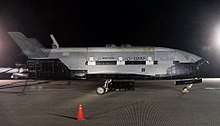
The first X-37B launched on its first mission - OTV-1/USA-212 - on an Atlas V rocket from Cape Canaveral Air Force Station, Florida, on 22 April 2010 at 23:52 UTC. The spacecraft was placed into low Earth orbit for testing.[17] While the U.S. Air Force revealed few orbital details of the mission, a worldwide network of amateur astronomers claimed to have identified the spacecraft in orbit. On 22 May 2010, the spacecraft was in an inclination of 39.99°, circling the Earth once every 90 minutes on an orbit 249 by 262 miles (401 by 422 km).[51][52] OTV-1 reputedly passed over the same given spot on Earth every four days, and operated at an altitude that is typical for military surveillance satellites.[53] Such an orbit is also common among civilian LEO satellites, and the spaceplane's altitude was the same as that of the ISS and most other crewed spacecraft.
The U.S. Air Force announced a 3–6 December landing on 30 November 2010.[54][55] As scheduled, the X-37B was de-orbited, reentered Earth's atmosphere, and landed successfully at Vandenberg AFB on 3 December 2010, at 09:16 UTC,[56][57][58] conducting the first US autonomous orbital landing onto a runway. This was the first such landing since the Soviet Buran shuttle in 1988. In all, OTV-1 spent 224 days and 9 hours in space.[17][56] OTV-1 suffered a tire blowout during landing and sustained minor damage to its underside.[21]
OTV-2
The second X-37B launched on its inaugural mission, designated OTV-2/USA-226,[59] aboard an Atlas V rocket from Cape Canaveral on 5 March 2011 at 22:46 UTC.[60] The mission was classified and described by the U.S. military as an effort to test new space technologies.[61] On 29 November 2011, the U.S. Air Force announced that it would extend USA-226 beyond the 270-day baseline duration.[62] In April 2012, General William L. Shelton of the Air Force Space Command declared the ongoing mission a "spectacular success".[63]
On 30 May 2012, the Air Force stated that the X-37B would land at Vandenberg AFB in June 2012.[64][65] The spacecraft landed autonomously on 16 June 2012, having spent 468 days and 14 hours in space.[60][66][67]
OTV-3
The third mission and second flight of the first X-37B, OTV-3 was originally scheduled to launch on 25 October 2012,[68] but was postponed because of an engine issue with the Atlas V launch vehicle.[69] It was successfully launched from Cape Canaveral on 11 December 2012 at 18:03 UTC.[48][70][71] Once in orbit, the spacecraft was designated USA-240.[72][73] Landing occurred at Vandenberg AFB on 17 October 2014 at 16:24 UTC, after a total time in orbit of 674 days and 22 hours.[70][74][75][76]
OTV-4
.jpg)
The fourth X-37B mission, OTV-4, was codenamed AFSPC-5 and designated as USA-261 in orbit. It was the second flight of the second X-37B vehicle.[19] The X-37B launched on an Atlas V rocket from Cape Canaveral Air Force Station on 20 May 2015 at 15:05 UTC.[77] Objectives included a test of Aerojet Rocketdyne's XR-5A Hall-effect thruster in support of the Advanced Extremely High Frequency communications satellite program,[33][78] and a NASA investigation on the performance of various materials in space[19][49][79] for at least 200 days.[19] The vehicle spent what was then a record-breaking 717 days and 20 hours in orbit before landing at Kennedy Space Center's Shuttle Landing Facility on 7 May 2017 at 11:47 UTC.[80][81]
OTV-5
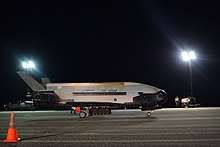
The fifth X-37B mission, designated USA-277 in orbit,[50] was launched on 7 September 2017 at 14:00 UTC, just before the arrival of Hurricane Irma.[82][83] The launch vehicle was a Falcon 9 rocket flying from Kennedy Space Center Launch Complex 39A,[84] and a number of small satellites also shared the ride.[85] The spacecraft was inserted at a higher inclination orbit than previous missions, further expanding the X-37B's envelope.[85] During the flight, the spacecraft modified its orbit using an on-board propulsion system.[86] While the complete payload for OTV-5 is classified, the Air Force announced that one experiment flying is the Advanced Structurally Embedded Thermal Spreader II (ASETS-II), which measures the performance of an oscillating heat pipe.[87] The mission was completed with the vehicle landing at the Shuttle Landing Facility on 27 October 2019 at 07:51 UTC.[1][88]
OTV-6 (USSF 7)
The sixth X-37B mission (OTV-6), US Space Force-7 (formerly known as AFSPC 7), launched on an Atlas V 501 rocket, from Cape Canaveral Air Force Station, SLC-41 on 17 May 2020 at 13:14 UTC.[2] The mission hosts more experiments than prior X-37B flights, including two NASA experiments. One is a sample plate evaluating the reaction of select materials to conditions in space. The second studies the effect of ambient space radiation on seeds. A third experiment designed by the Naval Research Laboratory (NRL) transforms solar power into radio frequency microwave energy, then studies transmitting that energy to Earth. The X-37B remains a Department of the Air Force asset, but the newly-established U.S. Space Force is responsible for the launch, on-orbit operations, and landing.[3][89]
The X-37B released a small, 136 kilograms (300 lb) satellite named FalconSAT-8 (USA-300), on 28 May 2020.[90] Developed by United States Air Force Academy cadets in partnership with the Air Force Research Laboratory (AFRL), the small satellite carries five experimental payloads. The spacecraft will test a novel electromagnetic propulsion system, low-weight antenna technology and a commercial reaction wheel to provide attitude control in orbit. According to the United States Air Force Academy, FalconSAT-8's experiments include:
- Magnetogradient Electrostatic Plasma Thruster (MEP) – Novel electromagnetic propulsion system
- Metamaterials Antenna (MMA) – Low size, weight, power antenna with phased-array like performance
- Carbon nanotube experiment (CANOE) – RF cabling with carbon nanotube braiding flexed using shape-memory alloy
- Attitude Control and Energy Storage (ACES) – Commercial reaction wheel modified into a flywheel for energy storage and release
- SkyPad – Off-the-shelf cameras and GPUs integrated into low-SWAP (size, weight and power) package
Variants
X-37A
The X-37A Approach and Landing Test Vehicle (ALTV) was an initial NASA version of the spacecraft used in drop glide tests in 2005 and 2006.[12][91]
X-37B
The X-37B is a modified version of the NASA X-37A, built for the U.S. Air Force.[23] Two were built and have been used for multiple orbital missions.[70]
X-37C
In 2011, Boeing announced plans for a scaled-up variant of the X-37B, referring to it as the X-37C. The X-37C spacecraft would be between 165% and 180% of the size of the X-37B, allowing it to transport up to six astronauts inside a pressurized compartment housed in the cargo bay. Its proposed launch vehicle was the Atlas V.[92] In this role, Boeing's X-37C could potentially compete with the corporation's CST-100 Starliner commercial space capsule.[93]
Specifications
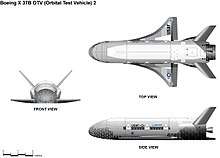
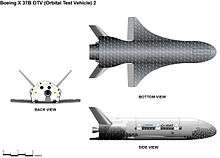
X-37B
Data from USAF,[23][40] Boeing,[94] Air & Space Magazine,[91] and PhysOrg.[95]
General characteristics
- Crew: none
- Length: 29 ft 3 in (8.92 m)
- Wingspan: 14 ft 11 in (4.55 m)
- Height: 9 ft 6 in (2.90 m)
- Max takeoff weight: 11,000 lb (4,990 kg)
- Electrical power: Gallium arsenide solar cells with lithium-ion batteries[23]
- Payload bay: 7 × 4 ft (2.1 × 1.2 m)[94]
Performance
- Orbital speed: 28,044 kilometres per hour (17,426 mph)[96]
- Orbit: Low Earth orbit
- Orbital time: 270 days (design)[97][N 2]
See also
- Boeing X-20 Dyna-Soar, the U.S. Air Force's previous spaceplane, which was canceled in the 1960s
- DARPA Falcon Project, a hypersonic missile-delivery and satellite-launch project
- Orbital Sciences X-34, a proposed uncrewed suborbital reusable-rocket technology testbed
Aircraft of comparable role, configuration and era
- Avatar (spacecraft), an Indian design intended for horizontal takeoff
- Dream Chaser, a crewed spaceplane being developed by Sierra Nevada Corporation
- HOPE-X, a similar-sized vehicle of comparable role by JAXA (cancelled)
- HYFLEX, a Japanese lifting body spaceplane in 1996, precursor to HOPE-X
- Intermediate eXperimental Vehicle (IXV), an ESA designed experimental reentry vehicle
- Shenlong (spacecraft), a Chinese design, first tested in 2011 (suborbital flight)
- Skylon (spacecraft), a British reusable uncrewed spaceplane in development
- Space Rider, a planned robotic spaceplane follow-up to IXV by ESA
Related lists
Notes
- Source of flights: mission markings posted on side of White Knight aircraft.
- This figure is based on pre-launch design estimates; it does not reflect the spacecraft's actual performance capacity. During its 2012–2014 test mission, the OTV-3 X-37B spent over 670 days in space.
References
Citations
- Clark, Stephen (27 October 2019). "U.S. military's X-37B spaceplane lands in Florida". Spaceflight Now. Retrieved 28 October 2019.
- Graham, William (17 May 2020). "ULA Atlas V launches sixth mission for X-37B spaceplane". NASASpaceFlight.com.
- "Payloads revealed for next flight of X-37B military spaceplane". spaceflightnow.com. Spaceflight Now. 6 May 2020. Retrieved 7 May 2020.
- "X-37 Technology Demonstrator: Blazing the trail for the next generation of space transportation systems" (PDF). NASA Facts. NASA. September 2003. FS-2003-09-121-MSFC

- "Air Force Bloggers Roundtable: Air Force set to launch first X-37B Orbital Test Vehicle". United States Department of Defense. 20 April 2010. Archived from the original on 24 April 2010. Retrieved 23 April 2010.
- Clark, Stephen (2 April 2010). "Air Force spaceplane is an odd bird with a twisted past". Spaceflight Now. Archived from the original on 5 April 2010. Retrieved 3 April 2010.
- "NASA, Boeing Enter Cooperative Agreement to Develop and Fly X-37 Technology Demonstrator" (Press release). NASA. 14 July 1999. Press Release 99-139. Archived from the original on 26 June 2015. Retrieved 20 October 2014.

- Yenne 2005, p. 277.
- Berger, Brian (15 September 2004). "NASA Transfers X-37 Project to DARPA". Space.com. Archived from the original on 5 September 2008. Retrieved 15 August 2008.
- Berger, Brian (16 September 2004). "DARPA takes on space plane project". NBC News. Archived from the original on 16 October 2014. Retrieved 19 October 2014.
- David, Leonard (23 June 2005). "White Knight carries X-37 aloft". CNN. Archived from the original on 9 November 2012. Retrieved 15 October 2012.
- Parsch, Andreas (November 2009). "Boeing X-37 / X-40". Designation-Systems.net. Archived from the original on 10 May 2012. Retrieved 2 August 2012.
- "Mojave web log entries". MojaveWeblog.com. Archived from the original on 4 June 2006. Retrieved 15 October 2012.
- David, Leonard (7 April 2006). "X-37 Flies at Mojave But Encounters Landing Problems". Space.com. Archived from the original on 6 June 2009. Retrieved 18 January 2009.
- "X-37 Test Flight B-Roll (No Audio)". YouTube.com. U.S. Air Force. 22 April 2010. Archived from the original on 25 June 2016. Retrieved 29 November 2016.
- David, Leonard (17 November 2006). "U.S. Air Force Pushes For Orbital Test Vehicle". Space.com. Archived from the original on 24 July 2008. Retrieved 17 November 2006.
- Clark, Stephen (22 April 2010). "Atlas rocket delivers Air Force spaceplane to orbit". Spaceflight Now. Archived from the original on 25 April 2010. Retrieved 23 April 2010.
- Clark, Stephen (25 February 2010). "Air Force X-37B spaceplane arrives in Florida for launch". Spaceflight Now. Archived from the original on 1 March 2010. Retrieved 3 March 2010.
- Krebs, Gunter. "X-37B OTV 1, 2, 3, 4". Gunter's Space Page. Archived from the original on 7 May 2015. Retrieved 21 May 2015.
- Covault, Craig (3 August 2008). "USAF To Launch First Spaceplane Demonstrator". Aviation Week. Archived from the original on 12 August 2011.
- Norris, Guy (7 December 2010). "Second X-37B Prepared For Launch". Aviation Week.
- Dean, James (8 October 2014). "NASA: Secret X-37B space plane will use shuttle hangars". Florida Today. Retrieved 9 October 2014.
- "Fact Sheet: X-37 Orbital Test Vehicle". U.S. Air Force. 21 May 2010. Archived from the original on 26 June 2014.
- Smith-Strickland, Kiona (27 May 2015). "Now We Know at Least Two Payloads on the X-37B". Air & Space/Smithsonian. Archived from the original on 27 May 2015. Retrieved 27 May 2015.
- Burghardt, Tom (11 May 2010). "The Militarization of Outer Space: The Pentagon's Space Warriors". Space Daily. Retrieved 15 October 2012.
- Parnell, Brid-Aine (6 January 2012). "US 'space warplane' may be spying on Chinese spacelab". The Register. Archived from the original on 8 January 2012. Retrieved 13 January 2012.
- Corocoto, Genalyn (9 January 2012). "Expert: U. S. Secret Space Plane Not Likely 'Spying' on China Module". International Business Times. Archived from the original on 11 January 2012. Retrieved 13 January 2012.
- Yuhas, Alan (27 October 2014). "X-37B secret space plane's mission remains mystery outside US military". The Guardian. Archived from the original on 28 October 2014. Retrieved 28 October 2014.
- Russon, Mary-Ann (7 November 2016). "Space race revealed: US and China test futuristic EmDrive on Tiangong-2 and mysterious X-37B plane". International Business Times. Retrieved 15 December 2016.
- Shawyer, Roger (November–December 2015). "Second generation EmDrive propulsion applied to SSTO launcher and interstellar probe" (PDF). Acta Astronautica. 116: 166–174. doi:10.1016/j.actaastro.2015.07.002.
- UK Department of Trade and Industry (2007). "Boeing End User Undertaking". Retrieved 15 December 2016.
- Hambling, David (5 November 2012). "Propellentless Space Propulsion Research Continues". Aviation Week & Space Technology. Retrieved 16 December 2016.
- Ray, Justin (27 April 2015). "X-37B launch date firms up as new details emerge about experiment". Spaceflight Now. Archived from the original on 29 April 2015. Retrieved 27 April 2015.
- Pawlyk, Oriana (23 July 2019). "Former SecAF Explains How Secret X-37 Space Plane Throws Off Enemies". Military.com. Retrieved 23 July 2020.
- Zhen, Liu (29 October 2019). "Does US space plane X-37B mark start of new military frontier?". South China Morning Post. Retrieved 23 July 2020.
- Miller 2001, p. 377.
- Grush, Loren (7 June 2017). "SpaceX scores contract to launch Air Force's secretive X-37B spaceplane". The Verge. Archived from the original on 4 September 2017. Retrieved 3 September 2017.
- David, Leonard (27 May 2005). "Mothership adopts a new space plane". NBC News. Archived from the original on 2 February 2014. Retrieved 2 February 2013.
- "X-37 Demonstrator to Test Future Launch Technologies in Orbit and Reentry Environments". NASA. May 2003. FS-2003-05-65-MSFC. Archived from the original on 24 October 2012. Retrieved 2 February 2013.

- Jameson, Austin D. (April 2001). "X-37 Space Vehicle: Starting a New Age in Space Control?" (PDF). Defense Technical Information Center. ADA407255. Archived (PDF) from the original on 19 October 2014. Retrieved 19 October 2014. Cite journal requires
|journal=(help) - "Mr. Gary Payton, Under Secretary of the Air Force for Space Programs, Media Teleconference (Pentagon), X-37B Launch" (PDF). Defense.gov. 20 April 2010. Archived from the original (PDF) on 25 January 2012. Retrieved 3 December 2010.
- David, Leonard (5 April 2012). "Boeing's New Crew-Carrying Spaceship Taking Shape". Space.com. Archived from the original on 7 April 2012. Retrieved 17 April 2012.
- "Pilotless US space plane lands after 469 days in orbit". Space Daily. AFP. 17 June 2012. Archived from the original on 27 June 2012. Retrieved 18 June 2012.
- Anderson, William E.; Butler, Kathy; Crocket, Dave; Lewis, Tim; McNeal, Curtis (2000). Peroxide Propulsion at the Turn of the Century. 4th International Symposium on Liquid Space Propulsion. 13 March 2000. Heilbronn, Germany. 5487a. Archived from the original on 7 August 2016. Retrieved 7 July 2017.
- Herbert, Bartt (24 July 2009). "Peroxide (H2O2) Test Programs, AR2-3 Flight Certification". NASA Engineering and Test Directorate. Archived from the original on 21 July 2011.
- Smith-Strickland, Kiona (February 2016). "What's the X-37 Doing Up There?". Air & Space/Smithsonian. Archived from the original on 7 April 2016. Retrieved 12 April 2016.
- Chertok, Boris E. (2005). Siddiqi, Asif A. (ed.). Rockets and People Ракеты и люди. NASA History Series. 1. NASA. p. 179. SP-2005-4110. Archived from the original on 6 October 2018. Retrieved 7 July 2017.

- Halvorson, Todd (9 December 2012). "AF's X-37B mini-shuttle shrouded in secrecy". Air Force Times. Florida Today. Archived from the original on 16 January 2013. Retrieved 10 December 2012.
- David, Leonard (8 May 2015). "Inside the US Air Force's Next X-37B Space Plane Mystery Mission". Space.com. Archived from the original on 10 May 2015. Retrieved 11 May 2015.
- Krebs, Gunter. "X-37B OTV 1, 2, 3, 4, 5, 6". Gunter's Space Page. Archived from the original on 7 September 2017. Retrieved 14 September 2017.
- David, Leonard (22 May 2010). "Secret X-37B Space Plane Spotted by Amateur Skywatchers". Space.com. Archived from the original on 25 May 2010. Retrieved 10 June 2010.
- "Amateur astronomers unravel X37-B orbit, say likely use for deploying spy satellites". News.com.au. 24 May 2010. Archived from the original on 27 May 2010. Retrieved 10 June 2010.
- Broad, William J. (21 May 2010). "Surveillance is Suspected as Spacecraft's Main Role". The New York Times. Archived from the original on 26 May 2010. Retrieved 22 May 2010.
- "Preparations underway for first landing of X-37B". U.S. Air Force. 30th Space Wing Public Affairs. 30 November 2010. Archived from the original on 5 March 2012. Retrieved 21 May 2012.
- "USAF X-37B Landing Slated for Dec. 3–6". Aviation Week. 30 November 2010. Retrieved 1 December 2010.
- Clark, Stephen (3 December 2010). "Home again: U.S. military space plane returns to Earth". Spaceflight Now. Archived from the original on 4 December 2010. Retrieved 3 December 2010.
- Warwicj, Graham (3 December 2010). "USAF's X-37B Spaceplane Returns to Earth". Aviation Week. Archived from the original on 6 June 2012. Retrieved 2 June 2012.
- Rincon, Paul (3 December 2010). "X-37B US military spaceplane returns to Earth". BBC News. Archived from the original on 4 December 2010. Retrieved 3 December 2010.
- McCants, Mike. "OTV 2 (USA 226) Satellite details 2011-010A NORAD 37375". N2YO.com. Archived from the original on 1 May 2012. Retrieved 8 April 2012.
- Clark, Stephen (5 March 2011). "Air Force's second robotic space shuttle circling Earth". Spaceflight Now. Archived from the original on 21 October 2016. Retrieved 20 October 2016.
- Wall, Mike (5 March 2011). "Secretive X-37B Space Plane Launches on New Mystery Mission". Space.com. Archived from the original on 3 April 2012. Retrieved 8 April 2012.
- Clark, Stephen (29 November 2011). "Military space shuttle receives mission extension". Spaceflight Now. Archived from the original on 1 December 2011. Retrieved 1 December 2011.
- David, Leonard (9 May 2012). "Air Force's secret X-37B a 'spectacular success'". NBC News. Archived from the original on 4 March 2016. Retrieved 10 May 2012.
- "Preparations underway for X-37B landing". U.S. Air Force. 30th Space Wing Public Affairs. 30 May 2012. Archived from the original on 2 June 2012. Retrieved 1 June 2012.
- David, Leonard (30 May 2012). "Air Force's Secretive X-37B Space Plane Will Land Soon". Space.com. Archived from the original on 2 June 2012. Retrieved 2 June 2012.
- "X-37B lands this morning at Vandenberg AFB". Santa Maria Times. 16 June 2012. Archived from the original on 25 October 2014.
- Wall, Mike (16 June 2012). "Air Force's secret X-37B space plane lands in California after mystery mission". Space.com. Archived from the original on 16 June 2012. Retrieved 16 June 2012.
- Ray, Justin (18 September 2012). "Another Atlas 5 readied to launch mini space shuttle". Spaceflight Now. Archived from the original on 22 September 2012. Retrieved 4 October 2012.
- McCullough, Amy (25 October 2012). "X-37B Launch Delayed". Air Force Magazine. Archived from the original on 20 February 2014. Retrieved 11 December 2012.
- Atkinson, Nancy (11 December 2012). "Air Force's Secret X-37B Space Plane Launches on Third Mission". Universe Today. Archived from the original on 14 December 2012. Retrieved 11 December 2012.
- David, Leonard (21 November 2012). "New Delay for Mysterious Military Space Plane Launch". Space.com. Archived from the original on 27 November 2012. Retrieved 26 November 2012.
- "NSSDC ID: 2012-071A". National Space Science Data Center. NASA. Retrieved 24 December 2012.

- Badger, Eric (11 December 2012). "Air Force launches 3rd X-37B Orbital Test Vehicle". U.S. Air Force. Archived from the original on 26 June 2014.
- Parsons, Dan (17 October 2014). "US Air Force's shadowy space plane lands after 674 days in orbit". Flight Global. Archived from the original on 18 October 2014. Retrieved 18 October 2014.
- "Secret space plane lands at US air force base after unknown two-year mission". The Guardian. Associated Press. 17 October 2014. Archived from the original on 17 October 2014. Retrieved 17 October 2014.
- Wall, Mike (17 October 2014). "X-37B Military Space Plane Lands After Record-Shattering Secret Mission". Space.com. Archived from the original on 19 October 2014. Retrieved 17 October 2014.
- Ray, Justin (20 May 2015). "Recap story: X-37B spaceplane embarks on fourth voyage in orbit". Spaceflight Now. Archived from the original on 12 October 2016. Retrieved 11 October 2016.
- "Aerojet Rocketdyne's Modified XR-5 Hall Thruster Demonstrates Successful On-Orbit Operation" (Press release). Aerojet Rocketdyne. 1 July 2015. Archived from the original on 9 July 2015. Retrieved 11 October 2016.
- Wall, Mike (20 May 2015). "US Air Force Launches X-37B Space Plane on 4th Mystery Mission". Space.com. Archived from the original on 21 May 2015. Retrieved 21 May 2015.
- Ray, Justin (7 May 2017). "X-37B spaceplane returns to Earth and makes autopilot landing in Florida". Spaceflight Now. Archived from the original on 8 May 2017. Retrieved 7 May 2017.
- Jackson, Amanda (8 May 2017). "Air Force's mysterious space plane lands, wakes up Florida". CNN. Archived from the original on 15 July 2017. Retrieved 12 July 2017.
- Grush, Loren (7 September 2017). "SpaceX launches Air Force's spaceplane just before Hurricane Irma reaches Florida". The Verge. Archived from the original on 7 September 2017. Retrieved 7 September 2017.
- Graham, William (7 September 2017). "SpaceX launches first X-37B launch with a Falcon 9". NASASpaceFlight.com. Archived from the original on 7 September 2017. Retrieved 7 September 2017.
- Bergin, Chris (9 September 2017). "SpaceX Falcon 9: X-37B OTV-5: September 7, 2017: Updates". NASASpaceFlight.com. Archived from the original on 9 September 2017. Retrieved 9 September 2017.
- "Air Force preparing to launch fifth Orbital Test Vehicle mission". Air Force Space Command. Air Force News Service. 31 August 2017. Archived from the original on 8 September 2017. Retrieved 1 September 2017.
- David, Leonard (15 August 2018). "Mysterious X-37B Military Space Plane Nears 1 Year in Orbit". Space.com. Archived from the original on 17 August 2018. Retrieved 17 August 2018.
- "Advanced Structurally Embedded Thermal Spreader II (ASETS-II)" (PDF). Air Force Research Laboratory. 10 August 2017. Archived (PDF) from the original on 27 August 2017. Retrieved 27 August 2017.
- Gallop, J. D. (27 October 2019). "U.S. Airforce's X-37B returns to Earth with a 'boom' and a new record for spaceflight". USA Today. Florida Today. Retrieved 28 October 2019.
- Secretary of the Air Force Public Affairs Next X-37B Orbital Test Vehicle Scheduled to Launch May 06, 2020
- https://www.planet4589.org/latest.html - 13 June 2020
- Klesius, Michael (January 2010). "Space Shuttle Jr". Air & Space Magazine. Archived from the original on 19 October 2014. Retrieved 19 October 2014.
- David, Leonard (7 October 2011). "Secretive X-37B US Space Plane Could Evolve to Carry Astronauts". Space.com. Archived from the original on 9 October 2011. Retrieved 10 October 2011.
- "Boeing vs. Boeing". Citizens in Space. 25 March 2012. Archived from the original on 6 April 2013. Retrieved 21 December 2012.
- "X-37B Orbital Test Vehicle". Boeing.com. Archived from the original on 21 March 2015. Retrieved 6 December 2010.
- Antczak, John (3 April 2010). "Air Force to launch robotic winged space plane". PhysOrg. Associated Press. Archived from the original on 4 January 2012. Retrieved 16 February 2013.
- Molczan, Ted (22 May 2012). "Re: X-37B OTV 2-1 search elements". Satobs.org. Archived from the original on 8 January 2014. Retrieved 2 June 2012.
- Evans, Michael (24 April 2010). "Launch of secret US space ship masks even more secret launch of new weapon". The Times. Archived from the original on 29 May 2010. Retrieved 25 April 2010.
General references
- Bentley, Matthew A. (2008). Spaceplanes: From Airport to Spaceport. New York: Springer. Bibcode:2009sfas.book.....B. ISBN 978-0-387-76509-9.CS1 maint: ref=harv (link)
- Gump, David P. (1989). Space Enterprise: Beyond NASA. Westport, CT: Praeger. ISBN 978-0-275-93314-2.CS1 maint: ref=harv (link)
- Miller, Jay (2001). The X-Planes: X-1 to X-45. Hinckley, UK: Midland. ISBN 978-1-85780-109-5.CS1 maint: ref=harv (link)
- Yenne, Bill (2005). The Story of the Boeing Company. Minneapolis, MN: Zenith. ISBN 978-0-7603-2333-5.CS1 maint: ref=harv (link)
External links
| Wikimedia Commons has media related to Boeing X-37. |
- X-37 Orbital Test Vehicle fact sheet from the U.S. Air Force
- X-37B Orbital Test Vehicle page at Boeing.com
- X-37 fact sheet at NASA.gov
- X-37, X-37A and X-37B pages at GlobalSecurity.org